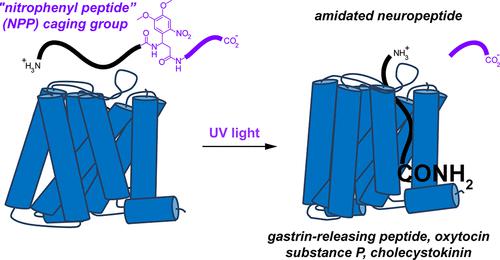当前位置:
X-MOL 学术
›
J. Am. Chem. Soc.
›
论文详情
Our official English website, www.x-mol.net, welcomes your
feedback! (Note: you will need to create a separate account there.)
A Biomimetic C-Terminal Extension Strategy for Photocaging Amidated Neuropeptides
Journal of the American Chemical Society ( IF 14.4 ) Pub Date : 2023-08-31 , DOI: 10.1021/jacs.3c03913
Aryanna E Layden 1 , Xiang Ma 1 , Caroline A Johnson 1 , Xinyi J He 1 , Stanley A Buczynski 1 , Matthew R Banghart 1
Journal of the American Chemical Society ( IF 14.4 ) Pub Date : 2023-08-31 , DOI: 10.1021/jacs.3c03913
Aryanna E Layden 1 , Xiang Ma 1 , Caroline A Johnson 1 , Xinyi J He 1 , Stanley A Buczynski 1 , Matthew R Banghart 1
Affiliation

|
Photoactivatable neuropeptides offer a robust stimulus–response relationship that can drive mechanistic studies into the physiological mechanisms of neuropeptidergic transmission. The majority of neuropeptides contain a C-terminal amide, which offers a potentially general site for installation of a C-terminal caging group. Here, we report a biomimetic caging strategy in which the neuropeptide C-terminus is extended via a photocleavable amino acid to mimic the proneuropeptides found in large dense-core vesicles. We explored this approach with four prominent neuropeptides: gastrin-releasing peptide (GRP), oxytocin (OT), substance P (SP), and cholecystokinin (CCK). C-terminus extension greatly reduced the activity of all four peptides at heterologously expressed receptors. In cell type-specific electrophysiological recordings from acute brain slices, subsecond flashes of ultraviolet light produced rapidly activating membrane currents via activation of endogenous G protein-coupled receptors. Subsequent mechanistic studies with caged CCK revealed a role for extracellular proteases in shaping the temporal dynamics of CCK signaling, and a striking switch-like, cell-autonomous anti-opioid effect of transient CCK signaling in hippocampal parvalbumin interneurons. These results suggest that C-terminus extension with a photocleavable linker may be a general strategy for photocaging amidated neuropeptides and demonstrate how photocaged neuropeptides can provide mechanistic insights into neuropeptide signaling that are inaccessible using conventional approaches.
中文翻译:

光笼蔽酰胺化神经肽的仿生 C 端延伸策略
光激活神经肽提供了强大的刺激-反应关系,可以推动对神经肽能传递的生理机制的机制研究。大多数神经肽含有 C 端酰胺,它为 C 端笼蔽基团的安装提供了潜在的通用位点。在这里,我们报告了一种仿生笼蔽策略,其中神经肽 C 末端通过光可裂解氨基酸延伸,以模拟大型致密核心囊泡中发现的原神经肽。我们用四种重要的神经肽探索了这种方法:胃泌素释放肽 (GRP)、催产素 (OT)、P 物质 (SP) 和胆囊收缩素 (CCK)。C 末端延伸大大降低了所有四种肽对异源表达受体的活性。在急性脑切片的细胞类型特异性电生理记录中,亚秒级的紫外线闪光通过激活内源性 G 蛋白偶联受体产生快速激活的膜电流。随后对笼中 CCK 进行的机制研究揭示了细胞外蛋白酶在塑造 CCK 信号传导时间动态中的作用,以及海马小清蛋白中间神经元中瞬时 CCK 信号传导具有惊人的开关样、细胞自主抗阿片类药物作用。这些结果表明,使用可光裂解接头进行 C 末端延伸可能是光笼酰胺化神经肽的通用策略,并证明光笼神经肽如何提供对神经肽信号传导的机制见解,而这是使用传统方法无法实现的。
更新日期:2023-08-31
中文翻译:

光笼蔽酰胺化神经肽的仿生 C 端延伸策略
光激活神经肽提供了强大的刺激-反应关系,可以推动对神经肽能传递的生理机制的机制研究。大多数神经肽含有 C 端酰胺,它为 C 端笼蔽基团的安装提供了潜在的通用位点。在这里,我们报告了一种仿生笼蔽策略,其中神经肽 C 末端通过光可裂解氨基酸延伸,以模拟大型致密核心囊泡中发现的原神经肽。我们用四种重要的神经肽探索了这种方法:胃泌素释放肽 (GRP)、催产素 (OT)、P 物质 (SP) 和胆囊收缩素 (CCK)。C 末端延伸大大降低了所有四种肽对异源表达受体的活性。在急性脑切片的细胞类型特异性电生理记录中,亚秒级的紫外线闪光通过激活内源性 G 蛋白偶联受体产生快速激活的膜电流。随后对笼中 CCK 进行的机制研究揭示了细胞外蛋白酶在塑造 CCK 信号传导时间动态中的作用,以及海马小清蛋白中间神经元中瞬时 CCK 信号传导具有惊人的开关样、细胞自主抗阿片类药物作用。这些结果表明,使用可光裂解接头进行 C 末端延伸可能是光笼酰胺化神经肽的通用策略,并证明光笼神经肽如何提供对神经肽信号传导的机制见解,而这是使用传统方法无法实现的。































 京公网安备 11010802027423号
京公网安备 11010802027423号